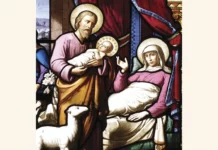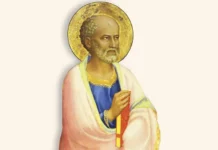Cardinal Sarto entered the conclave convinced that a great Pontiff would succeed Leo XIII, who would stand out, above all, for his holiness. The idea that he himself would be that Pope was the furthest thought from his mind…
When considering the Saints, many mistakenly imagine that they are out of the ordinary, predestined people, stars that glitter in the sky, while we “poor mortals” are as if doomed to live on earth, without the possibility of one day glittering with them.

This is a completely erroneous way of thinking about the spiritual life. The reality of the matter is altogether different, for the “formula for holiness” is found in the maxim given by Our Lord Jesus Christ: “He who is faithful in a very little is faithful also in much” (Lk 16:10).
The long journey of Pope St. Pius X is well summed up in these divine words.
A youth forged by hardship
Giuseppe Melchiorre Sarto, the second of ten children, was born on June 2, 1835, to a very humble family. His father, Giovanni Battista Sarto, was a postman in the town of Riese, Italy, and his mother, Margherita Sanson, a seamstress.
From childhood, he felt within himself the call to the priesthood. In order to guide him towards the fulfilment of this vocation, his parents were prepared to provide him with the necessary studies, even though they faced serious financial hardships. The boy, aware of his parents’ sacrifice, tried to relieve them of this burden in every way. For example, to go to school, he had to walk seven kilometres. In order not to wear out his shoes, he would take them off and tie them over his shoulders, only putting them back on when he was nearing his destination. And this at only eleven years of age!
Little Sarto soon learned to give due value to everything he received, including his schooling, and in this way he came to distinguish himself as one of the best students.
His priestly ministry begins
Having completed his seminary studies, Sarto was ordained priest in 1858 and sent to Tombolo as curate. During his time there, Fr. Sarto’s guiding principle was the salvation of souls, without counting the cost. His days were dedicated to the duties of his ministry, and in the evenings he prepared catechesis and sermons, as well as furthering his studies, especially by reading the works of St. Thomas Aquinas.
Fr. Antonio Costantini, the parish priest, gave this testimony about him: “I was sent as a curate a young man whom I was to prepare, but I think the opposite will happen: he is so zealous, so full of common sense and gifts that I shall learn from him.”1 Nevertheless, wishing to contribute to the younger priest’s formation, he fraternally corrected him on his preaching. It was not long before Fr. Sarto’s sermons stood out for their superior eloquence, logic and piety, and above all for their capacity to move hearts, to the point that Fr. Costantini even quipped: “Very well, very well. But it will not look good if the curate preaches better than the pastor…”2
Nine years later, Fr. Sarto received his first parish, in Salzano. With the experience of his previous assignment, he drew up a work plan that he would follow to the letter: visit all the faithful, preach the Word of God, be tireless in the confessional, comfort the sick and be available to assist the dying. All this without neglecting catechism, captivating everyone by his vivacity, good humour and the joy with which he taught the classes.
In 1873 a terrible cholera epidemic broke out in that region of Italy, claiming many lives. Without fear of contagion, Fr. Sarto redoubled his care for those whom Providence had entrusted to him. The parish church, instead of closing its doors to the faithful, went out to meet them in the person of its parish priest, who visited the sick to bring them solace.
At the end of that year, the young priest was worn out by his untiring efforts. But when he was urged to rest, he would reply, “Have no fear, the Lord helps me.”3
Supernatural and natural dynamism
After another nine years, God once again called him ad maiora. In 1876 Fr. Sarto received a letter from Bishop Zinelli of Treviso: “I have decided to give you three posts at once: canon, secretary of the diocesan curia and spiritual director of the seminary.”4
In Treviso, the Saint put his first efforts into the seminary. One of the two hundred young men formed there testified regarding Canon Sarto: “One had the impression that the Lord was speaking through him, because his words always responded to our needs and dispelled all fears.”5
In fact, he transmitted to the young men the strong sense of confidence in Providence that sustained his own interior life; an ample practical sense, capable of grasping and governing the concrete situation; and a congenial and communicative joy that chased away bitterness from the soul, making it agile and flexible for every undertaking.
Moreover, as a true Saint, he could not lack a deep devotion to Mary, the Mediatrix and Co-redemptrix of humanity. His piety moved him to organize a group of seminarians to carry out the liturgical functions on the feasts in honour of the Blessed Virgin in the cathedral.
In addition to his tireless dedication to those two hundred young men, he continued his catechism classes for children, his sermons in the diocesan churches and his work in the curia – such was his natural and supernatural dynamism!
In the Diocese of Mantua

Another nine years passed before a now-mature Fr. Sarto was raised to the episcopal order, assuming his office as the new Bishop of Mantua. The situation in the city was far from ideal, as the Saint himself recounted in a letter: “Here I am, ‘In partibus infidelium.’ Imagine that in a parish of thirty thousand souls, forty women attend the Bishop’s Mass, out of whom eight receive Holy Communion…”6 However, he never let this situation discourage him.
Remembering the good results obtained in Treviso, his first efforts in Mantua were concentrated on the seminary. Bishop Sarto needed clergy: “The only fruits my seminary offers me this year are the ordination of a priest and a deacon. What misery, and how my heart aches, when I am in need of at least forty!”7
However, let it be clearly understood that Bishop Sarto was not looking for numbers, but for ministers according to Our Lord’s heart. He was adamant when a seminarian did not show signs of a priestly vocation, and would counsel him to abandon the path to Holy Orders. He did so with sorrow, but with utmost determination, because life had taught him that when the formation of priests was guided by human calculations and earthly interests, they became a punishment of God.
Another of his great concerns was the diocesan clergy, with whom he met regularly to discuss pastoral matters, teaching them, above all, by example. When he learned that a certain priest customarily let his sleeping time cut into the hour set for hearing Confessions, Bishop Sarto prepared a surprise: when the priest finally entered the church, he found someone attending the penitents in his place. Lifting the curtain of the confessional, he beheld the Bishop who fixed him with a good-natured stare…
His commitment to promoting sacred music was also outstanding, as he wrote in 1893: “Gregorian chant is to be recommended, especially the way of singing it and making it popular. Oh, if only it were possible to get all the faithful to sing the fixed parts of the Mass – the Kyrie, the Gloria, the Credo, the Sanctus, the Agnus Dei – as they sing the Lauretanian Litanies and the Tantum ergo! For me, that would be the most beautiful achievement of sacred music, because in this way all the faithful, truly taking part in the Sacred Liturgy, would preserve their piety and devotion.”8
“The gem of the Sacred College”
When Archbishop Sarto was in his thirty-fifth year of pastoral ministry, nine of them as Bishop of Mantua, Leo XIII created him a Cardinal and appointed him to the Patriarchate of Venice.
The Venetian government, markedly anticlerical, was at first hostile to the new shepherd. However, armed with years of experience and acumen in the guidance of souls, he soon came to be loved and respected by the city of the doges, including its leaders.
Leo XIII regarded him with kindness and confidence and was in the habit of calling him “the gem of the Sacred College”9 and kept a photograph of the Cardinal among his possessions.
In 1903, upon this Pontiff’s death, the Princes of the Church from all over the world went to Rome to elect the new Successor of Peter. It is said that the Patriarch of Venice was the only Cardinal to buy a return ticket, so far from his thoughts was the idea of becoming Pope.
Shepherd of the entire world!

The conclave began and, after some ballots, not exempt from controversy, the direction of the voting began to indicate that Cardinal Sarto would be the successor of Leo XIII. Perceiving this, and considering the enormous responsibility of the post, he tried to dissuade the Sacred College, arguing, with tears in his eyes, that he was not worthy. But the Holy Spirit’s choice was made.
The then Monsignor Merry del Val, secretary of the conclave and future Secretary of State, was commissioned by the Cardinal Dean to obtain a definitive answer from the Cardinal. After a long search he found him kneeling before the altar of the Mother of Good Counsel in the Pauline Chapel, his face bathed in tears. Monsignor Merry del Val only had the strength to tell him: “Courage, Eminence!”
Finally, on August 4, 1903, Cardinal Sarto accepted his election as Supreme Pontiff, adopting the name of Pius X. Now his flock would no longer be Tombolo, Salzano, Treviso, Mantua or glorious Venice, but the whole world.
A short while later, St. Pius X received in audience the diplomatic corps, as was customary. It was a quick meeting, but so striking and profound that one of the diplomats, expressing a feeling shared by all, afterwards asked Monsignor Merry del Val: “Tell us, what is it about this man that attracts us so much?” The ecclesiastic limited himself to saying that he had met His Holiness days before and had been equally impressed. Later, being alone, he seemed to hear the reply: “It is because he is a man of God.”10
“To restore all things in Christ”
When asked about his political leanings, St. Pius X would point to a crucifix and declare: “This is my policy!”11 And this statement confirmed the plan of his pontificate: “Instaurare omnia in Christo.”12
St. Pius X was above all a great reformer. With over forty-five years of pastoral experience, he did as Pontiff what he had always done, only on a worldwide scale. Thus he gave profound attention to the catechism, promoting a new edition; he reformed the Liturgy, facilitating frequent Communion for the faithful and making it available to children – which earned him the title Pope of the Eucharist –, and placed increased weight on liturgical chant, especially Gregorian chant; he initiated the drafting of a new Code of Canon Law, and reorganized the Roman curia and dicasteries.
Furthermore, his fight against modernism was notable. The campaigns against this heresy and the promulgation of the Encyclical Pascendi Dominici Gregis – which contained passages written in his own hand – reveal another facet of his rich personality: in order to protect the sheep, the figure of the shepherd takes on that of a champion of God, who shines in defence of truth and condemnation of error.
It fell to St. Pius X to gather, analyse, outline and anathematize the modernist errors which, like a hidden seed, were infiltrating the flock of Christ. He had already been applying himself to this exacting work for some time. While still in Mantua and Venice, he studied and analysed the modernist books, never missing an opportunity to denounce their deviations.
The merited recognition
“For every matter has its time and way” (Eccl 8:6). In every situation, St. Pius X acted like a good physician: he took effective measures and cured the sick, even if the remedy seemed bitter to the palate at first. And time was able to judge his methods.
A quote by Benedict XV, who succeeded him on the pontifical throne, corroborates this statement: “I now understand how right Pius X was. When I was Substitute of the Secretariat of State and then Archbishop of Bologna, I was not entirely in agreement with him; but now I recognize how correct his thought was.”13
Even the press would recognize it, as this excerpt from the Parisian newspaper Les Temps shows: “Pius X never took into account those elements that ordinarily determine human decisions. He stood on his own ground: that of the divine. […] Because he was always inspired exclusively by his faith, he was a witness to the reality, the strength and the sovereignty of the spirit, not fearing to affirm that the Church lacks nothing to maintain itself, to fight, to live, provided it is free and remains always as it is.”14
“I am entirely resigned”

After so many battles, conquests and victories, the time had come for St. Pius X to join his voice to that of the Apostle when he asked God for the reward for having completed the good fight of the Faith.
After the feast of the Assumption of the Blessed Virgin Mary in 1914, the Pontiff felt somewhat unwell and his state of health suddenly worsened on the evening of August 18. His shield bearer, friend and spiritual son, Cardinal Merry del Val, came to his room the next morning and recounts that the last words heard from his lips were: “Your Eminence… Your Eminence! I am entirely resigned.”15
Like an immolated lamb that does not open its mouth, after this the Holy Pontiff lost the faculty of speech, although he remained completely lucid. From then on he merely stared deeply at those around him. That night, he entrusted his soul to God. The clock struck one fifteen in the morning of August 20, 1914.
It was the sunset of a brilliant pontificate. St Pius X had left this earth to shine for all eternity in Heaven and to intercede for the Church Militant, which he had so steadfastly defended during his life, for which he had fought and suffered! History reveres him as a great Pope, and the Mystical Spouse of Christ praises him as a great Saint. ◊
Notes
1 JAVIERRE, José Maria. Pío X. 2.ed. Juan Flors, 1952, p.63.
2 Idem, p.65.
3 DAL-GAL, OFM Conv, Jerónimo. San Pio X. Barcelona: Cristiandad, 1954, p.27.
4 JAVIERRE, op. cit., p.92.
5 DAL-GAL, op. cit., p.30.
6 JAVIERRE, op. cit., p.146.
7 DAL-GAL, op. cit., p.36.
8 Idem, p.44.
9 Idem, p.106.
10 MERRY DEL VAL, Rafael. São Pio X: um Santo que eu conheci de perto. Porto: Civilização, [n.d.], p.26; 28.
11 DAL-GAL, op. cit., p.289.
12 From the Latin: “To restore all things in Christ.”
13 JAVIERRE, op. cit., p.278.
14 DAL-GAL, op. cit., p.352.
15 MERRY DEL VAL, op. cit., p.141.







